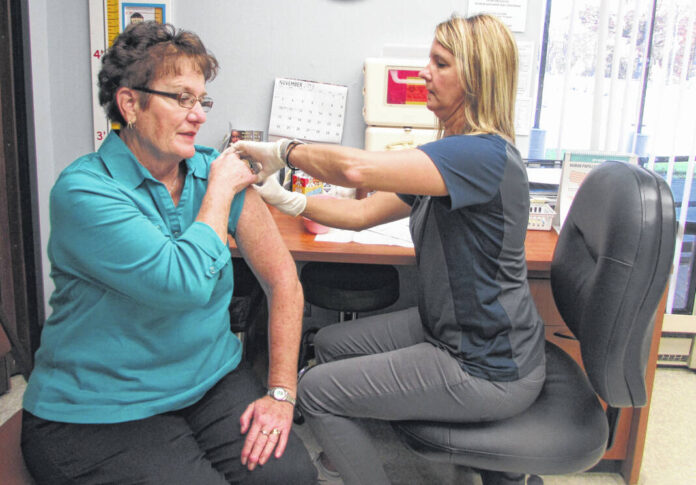
Many people have taken COVID precautions since 2020, like masking and social distancing, that have had the extra effect of making flu seasons less severe than previous years. As many people are now forgoing those precautions after two years, experts are warning of a resurgence in the typical flu season.
File photo | The Lima News
CLEVELAND, Ohio — The last two flu seasons have been a breeze. That’s over, health experts are predicting.
Expect a tougher flu season this year — one that is closer to a typical flu season ahead of the COVID-19 pandemic, with a peak that comes earlier than the typical February crescendo.
Why do experts think flu may come roaring back this winter?
For the past two flu seasons, social distancing, hand washing and mask wearing — measures to slow the spread of COVID-19 — also kept a check on the spread of influenza.
Now kids are back in school, masks are rarely worn in public and no one is planning a socially distanced Thanksgiving dinner.
“There’s less masking indoors and that leads to more potentially more contagious sharing of the flu virus that we haven’t seen in the past couple years,” said Sarah Edington, a pharmacist and CVS regional director.
A more robust influenza season could bring nearly 40 flu-related deaths and more than 2,000 flu-related hospitalizations just in Cuyahoga County. Those were the numbers during the last normal, pre-pandemic flu season in the county.
Compare that with the 2021-22 season, when Cuyahoga County recorded just one death.
“If you look at the flu mortality rate, these last two years have been really, really nice because we haven’t had hardly any influenza mortality,” said Dr. Amy Edwards, a pediatric infectious disease specialist at University Hospitals Rainbow Babies and Children’s Hospital in Cleveland. “In kids, we’ve had almost zero influenza mortality.”
Nationally, flu activity has been reported across most of the country this month, according to the U.S. Centers for Disease Control and Prevention. The highest levels of activity are in the southeast and south-central sections of the United States.
There are other reasons why the flu season we’re entering might be more serious than past years.
Diminished natural protection
People have less natural protection because they haven’t been exposed to the flu virus in the last two winters, and might not have gotten a flu vaccine because they didn’t think they were at risk, said Dr. Shanu Agarwal, chief medical officer for Summa Health.
During a normal flu season, as much as 30% of Americans generally get exposed to the flu virus, said Richard Webby, an influenza specialist at St. Jude Children’s Research Hospital and a member of the WHO Global Influenza Surveillance and Response System network.
But that hasn’t happened for the past two flu seasons, leading to lower immunity this season, Webby wrote in an opinion essay published in the health industry newsletter Med Page Today.
“A more susceptible population would equate to more influenza activity,” Webby said.
Health experts look to the Southern Hemisphere, which has its winter during our summer, for clues about the coming influenza season.
Even though a summary of the Australian health service says its season was mild to low, other observers have interpreted the Australian data as showing quite a lot of flu activity, but much of it was in children.
Overall, “the prediction is that our numbers are going to be definitely higher than we saw in the last two years,” Agarwal said.
So-called twindemic unlikely
Since the COVID-19 pandemic began, public health experts have worried about the possibility of a winter “twindemic” of surging COVID-19 and influenza that could overwhelm hospitals. It hasn’t happened yet, and it’s unlikely to do so this winter, Webby said.
“One may follow the other, but an overlap in peak activities might be biologically less likely,” Webby said.
Interaction among influenza, coronavirus and other common viruses, which epidemiologists are still studying, could slow the spread of influenza this winter, Webby said. He pointed to epidemiological data from earlier this year, when the spread of omicron appeared to slow an emerging surge in flu cases.
“We don’t yet understand the interaction between all these respiratory viruses during a pandemic,” said Michael Osterholm, director of the Center for Infectious Disease Research and Policy at the University of Minnesota.
Flu shot is a good match to circulating viruses
Because a stronger influenza season could be coming, it’s more important than ever to get a flu shot and COVID-19 booster. The best time to get the flu vaccine is September to October, Summa Health’s Agarwal said.
This season’s flu shot looks to be a good match against the flu strains in circulation, and should be fairly effective this year. It’s safe to get a COVID-19 booster and flu vaccine at the same time.
“It’s really important for us to make sure that we are protecting ourselves, not only from influenza, but also COVID-19,” said Dr. Kristin Englund, staff physician specializing in infectious diseases at the Cleveland Clinic.
Black, Hispanic, and American Indian/Alaska Native American adults are more likely to be hospitalized with flu, and less likely to be vaccinated against flu, according to a new CDC report.
During the 2021–2022 season, about 54% of whites and Asians got the flu vaccine, but only 42% of Blacks, 38% of Hispanics and 41% of American Indians/Alaska Natives.
Flu hospitalization rates were 80% higher among African-Americans than white Americans, 30% higher among American Indian/Alaska Natives and 20% higher for Hispanics.
Lack of access to health care, higher rates of chronic conditions and misinformation and distrust that contribute to lower levels of confidence in vaccines increase the risk of severe illness from flu, the CDC said.
Most people can get flu shots and COVID-19 booster shots at no charge. Some insurance plans only cover vaccines given by your doctor or at a limited set of locations.






